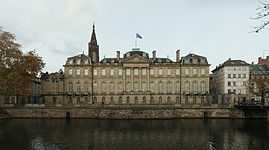Palais Rohan, Strasbourg


.jpg)

The Palais Rohan (Rohan Palace) is one of the most important buildings in the city of Strasbourg in Alsace, France. It represents not only the high point of local baroque architecture, according to widespread opinion among art historians, but has also housed three of the most important museums in the city since the end of the 19th century: the Archaeological Museum (Musée archéologique, basement), the Museum of Decorative Arts (Musée des Arts décoratifs, ground floor) and the Museum of Fine Arts (Musée des Beaux-arts, first and second floor). The city gallery, Galerie Robert Heitz, is also in a side wing of the palace.
Historical Overview
The palace was commissioned by Cardinal Armand Gaston Maximilien de Rohan, Bishop of Strasbourg, from the architect Joseph Massol and erected between 1731 and 1742 according to plans by Robert de Cotte. It was built on the site of the former residence of the Bishop, the so-called Palatium, which had been built from 1262 onwards. In 1744, Louis XV stayed in the palace, and Marie Antoinette stayed there in 1770. In 1805, 1806 and 1809, Napoléon Bonaparte stayed there and had some of the rooms changed to suit his tastes and those of his wife, Joséphine.[1] In 1810, Napoleon's second wife Marie Louise, Duchess of Parma spent her first night on French soil in the palace. Another royal guest was king Charles X of France in 1828. From 1872 until 1898, the palace served as the main building of the imperial German Universität Straßburg, up until the founding and opening of the new "Kaiser-Wilhelms-Universität". The art collection of the city (previously kept in the Aubette on the Place Kléber, which had been burned after Prussian artillery fire on August 24, 1870) had been completely destroyed during the Franco-Prussian War. As of 1898 and during the course of the re-establishment of the art collection, the palace became the seat of the imperial museums of Strasbourg. On August 11, 1944, the building was damaged by British and American bombs. The restoration of the premises was completed in the 1990s.
The Palace is listed as a Monument historique since 1920 by the French Ministry of Culture.[2]
Structure
The palace is built on a nearly square base which falls away toward the Ill River and is subdivided around a three-part inner court by a gallery. South of that, there is a main wing for the Prince-Archbishop, with its two representative Classic façades, which extends the entire width of the building. The most extravagant and overwhelming feature, from the viewpoint of the overall impression, is the façade which faces the Ill, with a small flat terrace with wrought-iron railings extending on both sides before it. The courtyard gate to the cathedral is wide and curved and has a roof with religious sculptures.
The chambers of the Prince-Archbishop, which can be viewed today in nearly their original condition, are divided into the grand appartement (display space, facing the river) and petit appartement (living space, facing the inner court), as in the Palace of Versailles. On both sides of the suites are the two most spacious rooms of the palace, the dining hall and the library, which both extend over the entire longitudinal axis of the wing. The library also serves as the nave of the castle's very small chapel.
Source
- Recht, Roland; Foessel, Georges; Klein, Jean-Pierre: Connaître Strasbourg, 1988, ISBN 2-7032-0185-0
References
See also
External links
| Wikimedia Commons has media related to Palais Rohan, Strasbourg. |